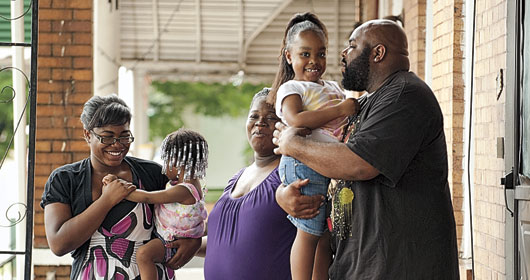Making Homes Healthier and More Energy Efficient in Baltimore

For years, Tarsha Mitchell rushed her oldest child, who suffers from asthma, to the hospital. “We’re well known in the emergency room,” she says.
But that is changing, thanks to home repairs designed to reduce health and safety hazards in the 104-year-old Baltimore house where Mitchell lives with her husband and four children. The work was done by Safe at Home, a Casey-supported program providing free repairs to the homes of asthma-diagnosed children in Baltimore City.
“They did a lot of work,” says Mitchell, whose five-year-old also has asthma. “Since then, we have not had any problems with asthma. It helped keep the dust down, the air clean, and we can open the living room window to air the place out. It’s been very helpful.”
Since 2000, Safe at Home has helped thousands of children by reducing home-based asthma triggers, safety threats, and lead-based paint hazards that cause illness and injury. “We’re trying to reduce the number of asthma episodes, school absences, and emergency room visits,” says Wes Stewart, program services director at the National Coalition to End Childhood Lead Poisoning based in Baltimore.
The coalition and the Casey Foundation are encouraging policymakers — from the White House to local communities — to incorporate this “healthy-homes” work into weatherization and energy-efficiency projects funded by the federal stimulus package.
“We are trying to ensure that the green, energy efficiency movement does not leave houses unhealthy but instead ensures a triple bottom-line of healthier housing, strong green jobs opportunities, and better outcomes for children,” says Ruth Ann Norton, the coalition’s executive director.
“As we go through hundreds of thousands of housing units over the next year with stimulus funds, we want to ensure that the workers, residents, and homes are safe from potential hazards that are present or could be exacerbated by such a huge intervention. Without healthy housing and lead safety standards, you could spend millions of dollars in neighborhoods to create quick shovel-ready jobs but cause lots of harm.”

Casey also is funding the coalition to provide support and advice to help cities where Casey is heavily involved to pursue healthy-homes work. “This harmonizes with our responsible redevelopment vision and wanting to have strong neighborhoods to support strong families that ultimately support strong kids,” says Salin Geevarghese, a Casey senior associate. The healthy-homes work supports Casey’s two-generation approach to reducing poverty, encompassing efforts to improve the economic stability and success of low-income parents while ensuring that their children are healthy and prepared to succeed in school and become productive citizens.
A lead-poisoned child is seven times more likely to drop out of school, and over 14 million school days are missed yearly by children due to asthma attacks. Adding a healthy-homes component to weatherization work also creates a pipeline for low income people to obtain skills and get higher paying, more sustainable jobs. “With skills in lead-safe work practices and healthy-housing training, we can move workers from $9 an hour to $16 to $21,” Norton notes.
These efforts resulted in a healthier home for Mitchell and her family, with lead hazards reduced by removing chipping and peeling lead-based paint and repainting, and by replacing lead-based windows. In addition, a smoke alarm with nine-year lithium batteries, a carbon monoxide detector, and electrical outlet caps were installed to reduce injury hazards; leaks and holes were repaired to reduce allergen-causing mold and pests; and the family received special mattress pads and pillow covers and a high-efficiency vacuum cleaner to reduce dust mites. An air filtering unit was also installed in the children’s bedroom.
“It’s a healthier environment for all of us,” says Mitchell.





